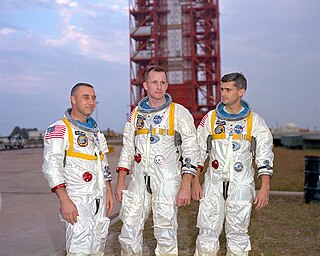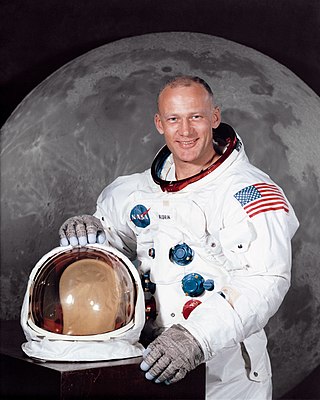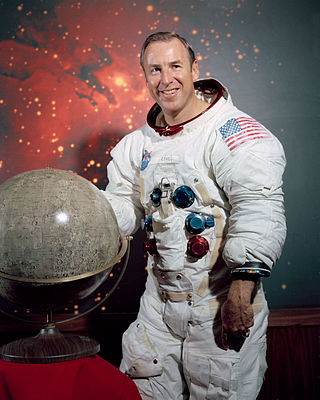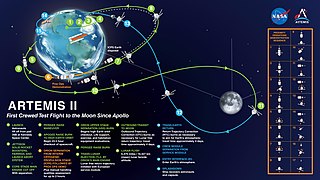
Apollo 11 was the American spaceflight that first landed humans on the Moon. Commander Neil Armstrong and Lunar Module Pilot Buzz Aldrin landed the Apollo Lunar Module Eagle on July 20, 1969, at 20:17 UTC, and Armstrong became the first person to step onto the Moon's surface six hours and 39 minutes later, on July 21 at 02:56 UTC. Aldrin joined him 19 minutes later, and they spent about two and a quarter hours together exploring the site they had named Tranquility Base upon landing. Armstrong and Aldrin collected 47.5 pounds (21.5 kg) of lunar material to bring back to Earth as pilot Michael Collins flew the Command Module Columbia in lunar orbit, and were on the Moon's surface for 21 hours, 36 minutes before lifting off to rejoin Columbia.

Apollo 8 was the first crewed spacecraft to leave low Earth orbit and the first human spaceflight to reach the Moon. The crew orbited the Moon ten times without landing, and then departed safely back to Earth. These three astronauts—Frank Borman, James Lovell, and William Anders—were the first humans to witness and photograph the far side of the Moon and an Earthrise.

The Apollo program, also known as Project Apollo, was the third United States human spaceflight program carried out by the National Aeronautics and Space Administration (NASA), which succeeded in preparing and landing the first humans on the Moon from 1968 to 1972. It was first conceived in 1960 during President Dwight D. Eisenhower's administration as a three-person spacecraft to follow the one-person Project Mercury, which put the first Americans in space. Apollo was later dedicated to President John F. Kennedy's national goal for the 1960s of "landing a man on the Moon and returning him safely to the Earth" in an address to Congress on May 25, 1961. It was the third US human spaceflight program to fly, preceded by the two-person Project Gemini conceived in 1961 to extend spaceflight capability in support of Apollo.

Apollo 13 was the seventh crewed mission in the Apollo space program and the third meant to land on the Moon. The craft was launched from Kennedy Space Center on April 11, 1970, but the lunar landing was aborted after an oxygen tank in the service module (SM) failed two days into the mission. The crew instead looped around the Moon in a circumlunar trajectory and returned safely to Earth on April 17. The mission was commanded by Jim Lovell, with Jack Swigert as command module (CM) pilot and Fred Haise as Lunar Module (LM) pilot. Swigert was a late replacement for Ken Mattingly, who was grounded after exposure to rubella.

Apollo 1, initially designated AS-204, was planned to be the first crewed mission of the Apollo program, the American undertaking to land the first man on the Moon. It was planned to launch on February 21, 1967, as the first low Earth orbital test of the Apollo command and service module. The mission never flew; a cabin fire during a launch rehearsal test at Cape Kennedy Air Force Station Launch Complex 34 on January 27 killed all three crew members—Command Pilot Gus Grissom, Senior Pilot Ed White, and Pilot Roger B. Chaffee—and destroyed the command module (CM). The name Apollo 1, chosen by the crew, was made official by NASA in their honor after the fire.

Buzz Aldrin is an American former astronaut, engineer and fighter pilot. He made three spacewalks as pilot of the 1966 Gemini 12 mission. He was the Lunar Module Eagle pilot on the 1969 Apollo 11 mission and became the second person to walk on the Moon after mission commander Neil Armstrong.

Frank Frederick Borman II is an American retired United States Air Force (USAF) colonel, aeronautical engineer, NASA astronaut, test pilot, and businessman. He was the commander of Apollo 8, the first mission to fly around the Moon, and together with crewmates Jim Lovell and William Anders, became the first of 24 humans to do so, for which he was awarded the Congressional Space Medal of Honor. As of 2023, he is the oldest living former American astronaut, eleven days older than Lovell.

William Alison Anders is a retired United States Air Force (USAF) major general, former electrical engineer, nuclear engineer, NASA astronaut, and businessman. In December 1968, he was a member of the crew of Apollo 8, the first three people to leave low Earth orbit and travel to the Moon. Along with fellow astronauts Frank Borman and Jim Lovell, Anders circled the Moon ten times, and broadcast live images and commentary back to Earth. During one of the mission's lunar orbits, he took the iconic Earthrise photograph.

Michael Collins was an American astronaut who flew the Apollo 11 command module Columbia around the Moon in 1969 while his crewmates, Neil Armstrong and Buzz Aldrin, made the first crewed landing on the surface. He was also a test pilot and major general in the U.S. Air Force Reserve.

James Arthur Lovell Jr. is an American retired astronaut, naval aviator, test pilot and mechanical engineer. In 1968, as command module pilot of Apollo 8, he became, with Frank Borman and William Anders, one of the first three astronauts to fly to and orbit the Moon. He then commanded the Apollo 13 lunar mission in 1970 which, after a critical failure en route, circled the Moon and returned safely to Earth.

Project Gemini was NASA's second human spaceflight program. Conducted between projects Mercury and Apollo, Gemini started in 1961 and concluded in 1966. The Gemini spacecraft carried a two-astronaut crew. Ten Gemini crews and 16 individual astronauts flew low Earth orbit (LEO) missions during 1965 and 1966.

NASA Astronaut Group 2, also known as the Next Nine and the New Nine, was the second group of astronauts selected by the National Aeronautics and Space Administration (NASA). Their selection was announced on September 17, 1962. The group augmented the Mercury Seven. President John F. Kennedy had announced Project Apollo, on May 25, 1961, with the ambitious goal of putting a man on the Moon by the end of the decade, and more astronauts were required to fly the two-man Gemini spacecraft and three-man Apollo spacecraft then under development. The Mercury Seven had been selected to accomplish the simpler task of orbital flight, but the new challenges of space rendezvous and lunar landing led to the selection of candidates with advanced engineering degrees as well as test pilot experience.

On Christmas Eve, December 24, 1968, the crew of Apollo 8 read from the Book of Genesis as they orbited the Moon. Astronauts Bill Anders, Jim Lovell, and Frank Borman, the first humans to travel to the Moon, recited verses 1 through 10 of the Genesis creation narrative from the King James Bible. Anders read verses 1–4, Lovell verses 5–8, and Borman read verses 9 and 10.
Around the world, television sets glowed with the broadcast. One in four people on Earth—roughly a billion people spread among 64 countries—listened to the reading. Within 24 hours, recorded broadcasts of the address from the moon reached people in another 30 countries. Audiences in North and South America as well as Europe tuned in live thanks to the recently launched Intelsat 3 satellite. COMSAT put the satellite into operation a week ahead of schedule so that international audiences could follow the flight.

Earthrise is a photograph of Earth and part of the Moon's surface that was taken from lunar orbit by astronaut William Anders on December 24, 1968, during the Apollo 8 mission. Nature photographer Galen Rowell described it as "the most influential environmental photograph ever taken".
Robert A. Kurson is an American author, best known for his 2004 bestselling book, Shadow Divers, the true story of two Americans who discover a World War II German U-boat sunk 60 miles off the coast of New Jersey.
Rocket Science is a miniseries first released in 2002-2003, chronicling the major events in the American-Soviet space race, starting from the first hypersonic rocket planes through the development of human space flight, culminating with the mission by mission history of Projects Mercury, Gemini and Apollo. The series features interviews with X-1 and X-15 pilots Chuck Yeager, Scott Crossfield and Pete Knight, astronauts Gordon Cooper, Wally Schirra, Scott Carpenter, Gene Cernan, Frank Borman, James Lovell, Buzz Aldrin and Alan Bean, flight controllers Gene Kranz, Christopher Kraft, John Hodge and Sy Liebergot, engineers Günter Wendt, Max Faget, John Houbolt, Bob Gore, Robert Sieck and Richard Dunne, authors Arthur C. Clarke, Andrew Chaikin, Robert Godwin, Spider Robinson and Robert J. Sawyer, historians Paul Fjeld and Professor John Lienhart, Dr Raymond Puffer and Dr James Young, Manhattan Project physicist Hans Bethe, head of the Lovelace Clinic Dr. Donald E. Kilgore, Dr David Simons of Holloman AFB, Colonel Joe Kittinger, and broadcaster Walter Cronkite, among others. While focusing mainly on the American side of the race, the series also covered major Soviet achievements through every key phase of the 1950s and 1960s Space Race.

Artemis 2 is the second scheduled mission of NASA's Artemis program and the first scheduled crewed mission of NASA's Orion spacecraft, currently planned to be launched by the Space Launch System (SLS) in November 2024. Four astronauts are to perform a flyby of the Moon and return to Earth, being the first crewed mission beyond low Earth orbit since Apollo 17 in 1972. The mission is also planned to be the first crewed launch from Launch Complex 39B of the Kennedy Space Center since STS-116 in 2006.
First to the Moon: The Story of Apollo 8 is a 2018 documentary film about the second crewed spaceflight mission in the United States Apollo space program, which launched on December 21, 1968. Apollo 8 was the first crewed spacecraft to leave low Earth orbit, reach the Moon, orbit it, and return safely to Earth. The film was released in December 2018 and has been screened at The Explorers Club in New York City, the Kansas Cosmosphere, and Arizona State University.














